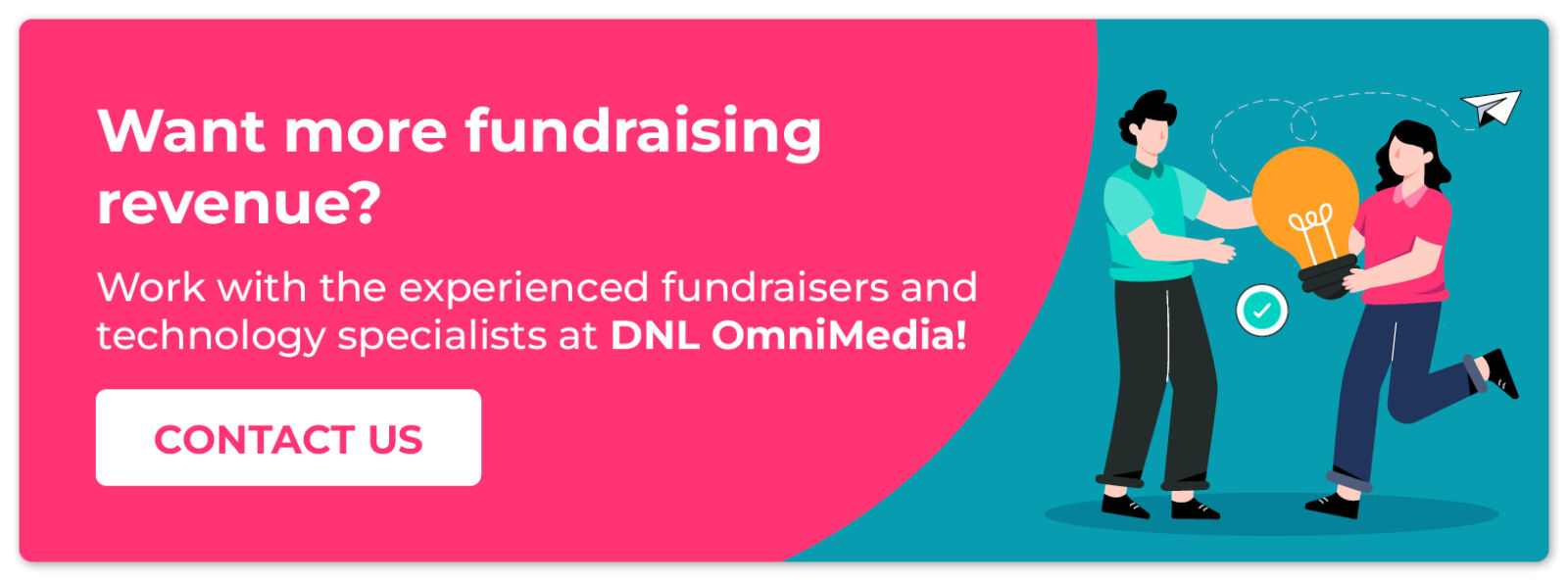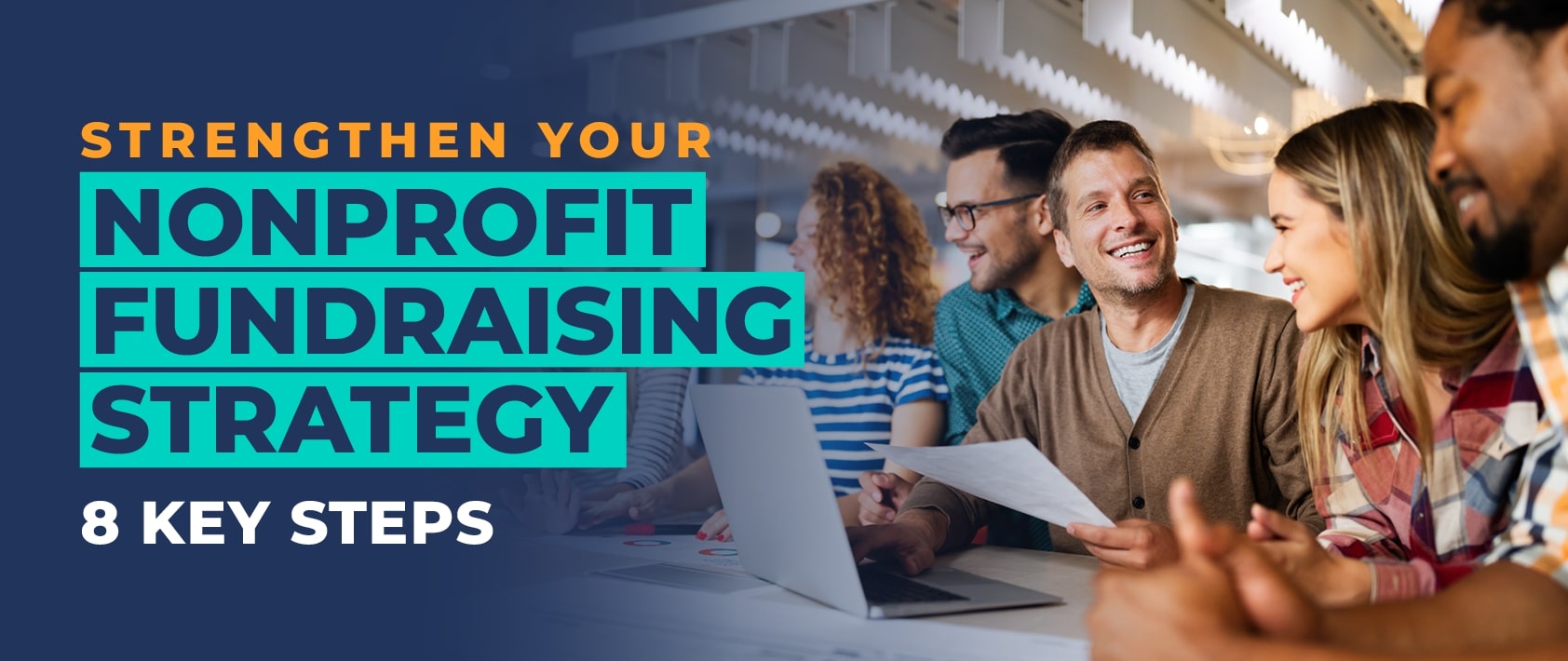Think back to your nonprofit’s most recent fundraising campaign. How did it go?
Maybe you met your fundraising goal, in part thanks to your committed volunteers, and had several meaningful touchpoints with high-impact donors. Or, perhaps you fell short of your goal and wonder how your fundraiser got off track.
Whatever the results of this single campaign, there is always room for improvement when it comes to your nonprofit’s larger fundraising strategy. After all, organizational needs, donor preferences, fundraising tools, and best practices are always evolving. So, for your nonprofit to succeed now and grow sustainably over time, you need to be flexible and continually strengthen your strategy.
At DNL OmniMedia, we’re well-versed in the complicated world of fundraising and fundraising technology. We’ve created this guide to help you bolster your nonprofit fundraising strategy and ultimately raise more for your cause. Here is what we’ll cover:
- Nonprofit Fundraising Strategies: An Overview
- 8 Steps to Build a Better Nonprofit Fundraising Strategy
- Fresh Fundraising Ideas to Engage Donors & Raise More
- How DNL OmniMedia Can Help
To continually refine your fundraising approach, you may find it helpful to partner with a third-party expert like a nonprofit consultant. These professionals can objectively assess your current strategy and tools, highlighting potential blindspots and opportunities for growth. That being said, let’s begin!

Nonprofit Fundraising Strategies: An Overview
What is a nonprofit fundraising strategy?
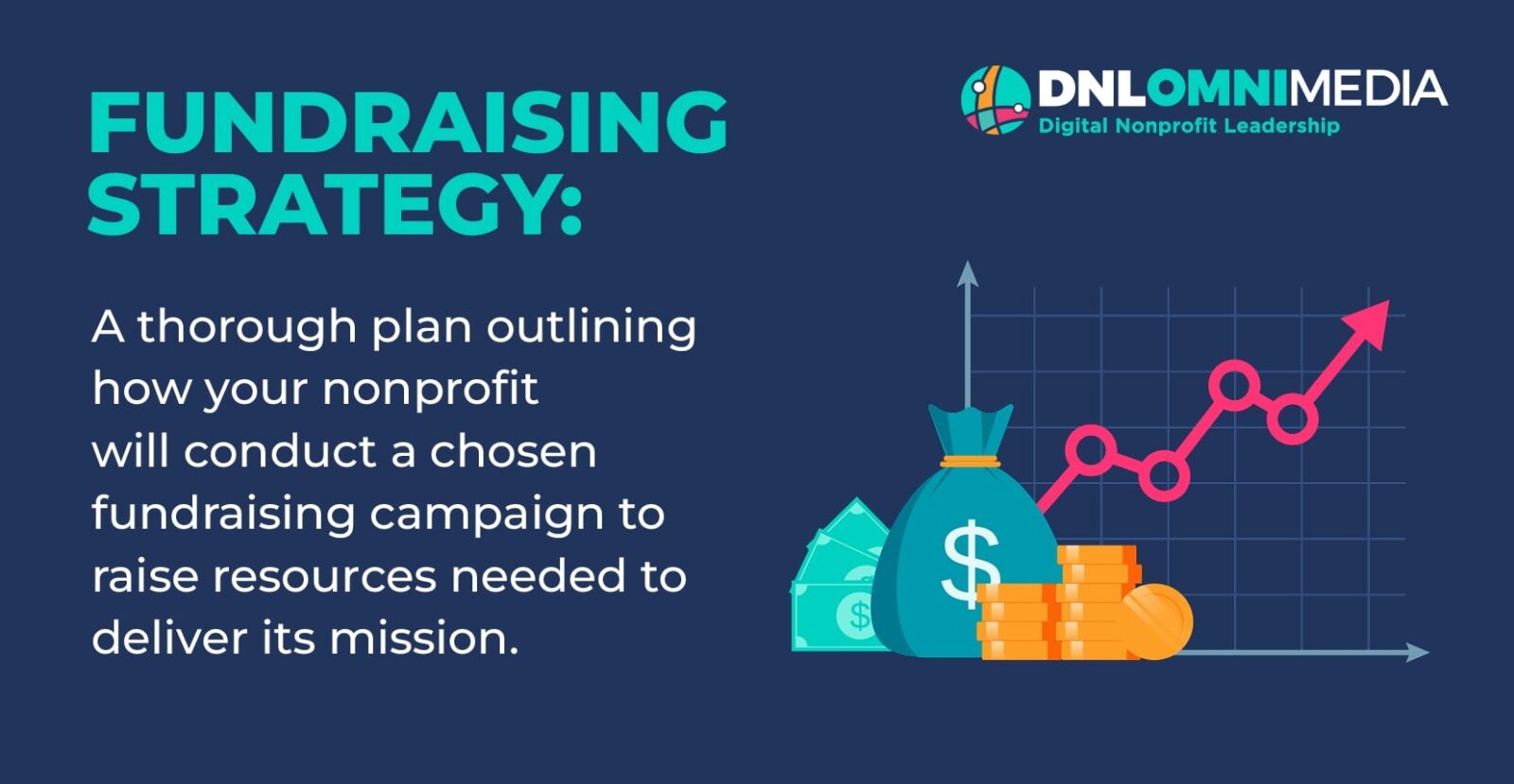
A fundraising strategy is a thorough plan outlining how your nonprofit will conduct a chosen fundraising campaign to raise resources needed to deliver its mission.
Typically a fundraising strategy includes specific goals, tools, techniques, and processes that help you plan campaigns, promote them, secure donations, and build strong relationships with supporters. However, the scope and specifics of your fundraising strategy will vary based on your organization’s size, needs, and experience level.
No matter what your unique fundraising strategy looks like now, remember that as you take the necessary steps to strengthen it, your strategy should be sustainable and pave the way for future growth.
Why is it important to have a fundraising strategy?
While in theory you could organize fundraising campaigns as needs come up and cross your fingers for good results, mapping out your strategy ahead of time is a much better move. Here are some of the benefits of having a thorough (yet flexible!) nonprofit fundraising strategy:
- Consistent funding: A well-thought-out fundraising strategy empowers your organization to continually engage in fundraising. Plus, since your strategy will help you play to your strengths and take into account your donors’ preferences, your revenue streams will become more reliable. This results in financial stability that makes it easier to accomplish your short-term goals and plan for your organization’s future.
- More efficient workflows: Everyone on your team has a part to play in fundraising, whether that means creating campaign marketing materials, meeting with major donors, or helping set up ahead of an event. A clear strategy allows your entire team to stay on the same page so they can accomplish the tasks they are responsible for and support each other on the way to your campaign goal.
- Better resource allocation: Efficiency is crucial for nonprofits since you’re typically working with limited resources. The right fundraising strategy helps you prioritize your biggest funding needs and successfully allocate the necessary time, energy, and resources toward accomplishing your goals.
- Clearer messaging: Well-articulated goals and marketing plans are an important part of any fundraising strategy. They’ll guide how you talk to the public about your fundraising campaign, ensuring consistency across channels that boosts your organization’s credibility and encourages support.
- Increased donor retention and engagement: More important than the dollars you raise during a fundraising campaign are the relationships you have with your supporters. By building your fundraising strategy around their needs, expectations, preferences, and priorities, you can continually engage donors and secure their support for the long term.
5 Crucial Elements of a Strong Fundraising Strategy
While we’ll walk through the steps to improve your fundraising strategy below, there are some crucial elements your team should incorporate into its strategy from the get-go. These are:
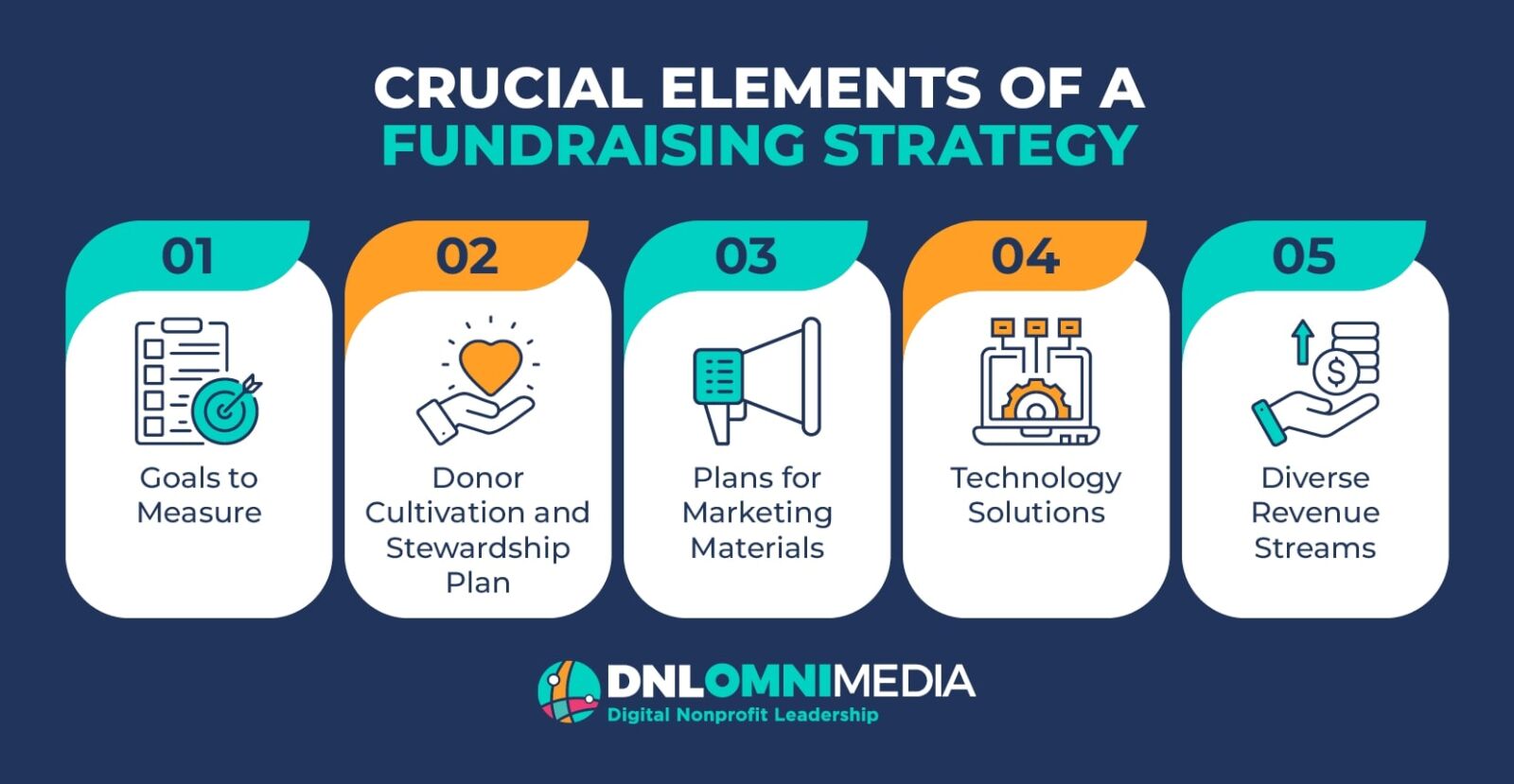
- Goals to measure: Goals not only motivate your team to work hard and put their best foot forward, but they also allow you to measure your progress over time and set you up to make improvements to your fundraising strategy in the future. In addition to financial goals, you can also set fundraising campaign goals related to donor and volunteer engagement, event attendance, corporate partnerships, and marketing performance.
- Donor cultivation and stewardship plan: Remember that relationships are what truly matters when it comes to fundraising. Ensure you have a clear plan for cultivating new donors and stewarding existing donors baked into your fundraising strategy. You can think of any work you do to strengthen donor relationships as an investment in your organization’s future—the longer a donor remains loyal to your nonprofit, the more value they will provide to your mission.
- Plans for marketing materials: Your marketing campaigns will only if you spread the word about them. Incorporate thorough marketing plans into your fundraising strategy, outlining which channels, types of messaging, and forms of social proof have worked for you in the past. This can guide the creation of new marketing materials.
- Technology solutions: Technology plays a big role in fundraising in the 21st century. Your strategy should include plans to leverage your existing technology stack (and, if needed, steps to take to improve or add to your technology stack). You may plan to use solutions like your constituent relationship management (CRM) system, online fundraising tools, and social media platforms, among others.
- Diverse revenue streams: For your fundraising strategy to be sustainable, you need multiple ways of consistently bringing in fundraising revenue. Incorporate different revenue streams into your fundraising plan—online donation forms, a recurring giving program, and fundraising events are just the beginning of the possibilities available to your organization. The beauty of diverse revenue streams is that if you face challenges with one or two sources, other streams can support your work while you fix problem areas.
The Current Nonprofit Fundraising Landscape
Your fundraising activities don’t take place in a vacuum, meaning that it’s important to keep a pulse on current trends and best practices, as well as external factors in the economy or society that may affect your fundraising success. Let’s review what the nonprofit fundraising landscape looks like currently.
The State of Total Giving
According to Giving USA 2024, individuals, bequests, and foundations gave an estimated total of $517.16 billion to U.S. charities in 2023. Though this is a 1.9% increase from giving in 2022 in current dollars, when adjusted for inflation, giving actually dipped by 2.1%.
Though this may seem concerning at first, experts remain optimistic. According to the Indiana University Lily Family School of Philanthropy, it’s a positive sign that Americans continued to give in 2023 despite an elevated cost of living and the threat of a possible recession.
So, while your organization should work to improve your fundraising strategies and keep relationships with donors strong, you can still feel confident in your ability to earn support.
Fundraising Challenges Nonprofits Face
According to the 2024 Fundraising Outlook report from OneCause, nonprofits cite donor fatigue and donor engagement as their top fundraising challenges. Other challenges include recurring giving, year-over-year fundraising growth, donor retention, and competing with other nonprofits for support.
This information indicates that for your nonprofit to grow sustainably over time, you need to genuinely connect with your donors and encourage their continual support in creative and refreshing ways. (Get some new ideas below!)
Emerging Trends to Embrace
- Donor-advised funds (DAFs) are one of the fastest-growing forms of charitable giving. (Giving USA 2024)
- Implications: Tap into new sources of revenue by offering donors the chance to give non-cash gifts like grants from DAFs or gifts of stock or cryptocurrency.
- Planned giving grew to $42.68 billion in 2023 and was the only nonprofit giving source to outpace inflation (Giving USA 2024)
- Implications: Actively market your planned giving program (or build one if you don’t have one already) to secure gifts for your nonprofit’s future.
- $2-3 billion dollars is donated in corporate matching gifts each year, but an estimated $6-10 billion goes unclaimed each year, mostly because donors don’t know their employers offer gift matching. (Double the Donation)
- Implications: To encourage your donors to take advantage of matching gift programs, you need to educate them about matching gifts and make it easy to initiate the process.
- As of 2024, 58% of nonprofits have incorporated AI into their communication processes, and 68% use it to assist with data analysis. Both rates outpace AI implementation in the for-profit sector. (The NonProfitTimes)
- Implications: AI use is only going to become more prevalent in the world of nonprofits as organizations use AI tools to better analyze their data, target donors, and create communications materials. Learning about these tools and how to use them in ethical ways is critical to future fundraising success.
- 84% of Gen Zers report that they support nonprofits in some way, and 70% say impact reporting helps motivate giving. (Blackbaud)
- Implications: As the newest generation of supporters, it’s vital for your nonprofit to pay attention to Gen Z and their preferences. These donors communicate and give in different ways than older generations, so becoming well-versed in newer social media platforms (such as TikTok and Instagram) and demonstrating your organization’s impact in communications will be critical to securing their support.
Of course, this is just a quick overview of the current fundraising landscape. Using what you know about your organization’s unique pain points and supporter preferences, continue to do your research and stay up to date on the external factors that could impact your own fundraising strategy. This will help you be prepared no matter what the future brings.
8 Steps to Build a Better Nonprofit Fundraising Strategy
No matter your starting point, systematically refining your fundraising strategy will make you more aware of your organization’s fundraising strengths and weaknesses and allow you to make careful improvements. Let’s walk through eight steps to build a better nonprofit fundraising strategy:
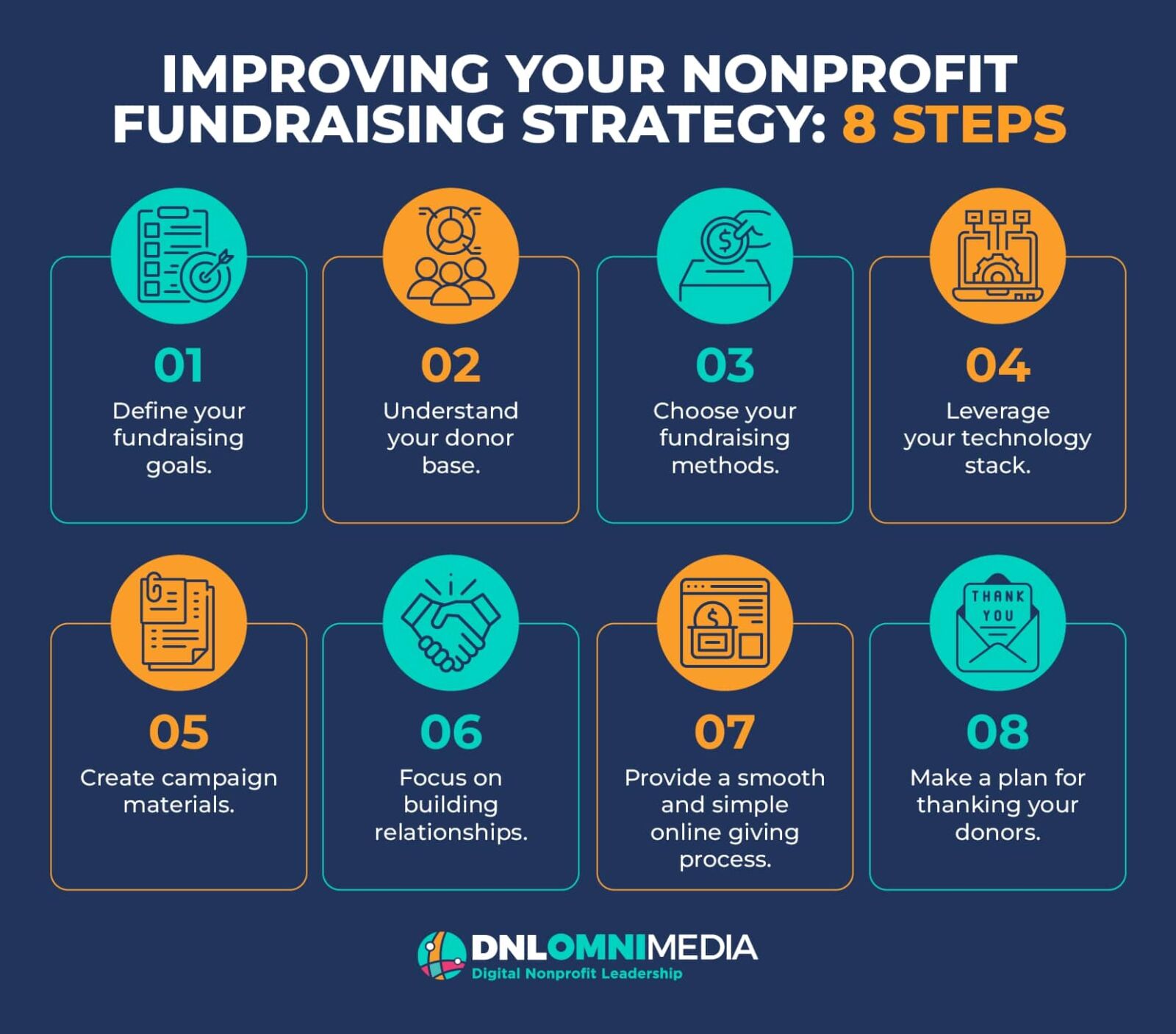
1. Define your fundraising goals.
Determine what you want to achieve through your fundraising campaign. Your goals should be specific, measurable, achievable, relevant, and time-based.
For example, say you’re gearing up for your nonprofit’s GivingTuesday campaign. You might set the following goals:
- By October 1, secure a commitment from an actively engaged major donor to match all online and mobile donations made to our nonprofit on GivingTuesday.
- Recruit 10 additional volunteers by November 20 to run our booth at our local holiday market on GivingTuesday.
- Raise $15,000 total by the end of the day on GivingTuesday.
No matter the specifics, write out all of the goals you want to accomplish and what will go into achieving them. This will help your entire team stay on track and measure its progress as the campaign progresses.
2. Understand your donor base.
Planning a successful fundraising campaign hinges on considering your donors’ needs and preferences. To ensure you’re designing a campaign that will inspire your donors to give, review the following sources of information:
- Donor data in your CRM, database, or data warehouse: Your donor data provides insights into your supporters’ demographics, giving history, and engagement patterns. Use this information to segment your broader donor base for more tailored marketing efforts and build campaigns that you’re confident donors will respond to based on past behavior.
- Donor surveys, focus groups, or interviews: You can also go straight to the source—donors themselves! Ask donors why they support your cause and what they want to see more of from your organization. Get their feedback on your previous campaigns and events, or seek their thoughts on your marketing materials. Once you’ve gathered these insights, take action on them and let participants know about the changes you’ve made with their help. This provides the added bonus of strengthening your relationships with donors while also giving your team valuable information.
- Marketing and fundraising platform analytics: Look at specific tools like your email marketing system or social media management tools to better understand how messages about your organization and fundraising efforts are being received. You can also look at fundraising tools like your peer-to-peer (P2P) fundraising platform or your website to better understand the donor journey and what obstacles you may need to remove to make the giving process easier.
- Prospect research tools: According to the 80/20 rule of fundraising, 80 percent of your organization’s fundraising revenue comes from just 20% (or less!) of your donors. These are your major donors, the donors who give your organization its largest gifts. To better understand your current major donors and discover new prospects, use prospect research tools to identify donors with philanthropic, affinity, and wealth markers that indicate they may be in a good position to give a large gift. You can even use prospect research tools powered by AI to help your major gift officers prioritize prospects and discover the best ways to reach out and begin building relationships with them.
Don’t settle for basing your fundraising strategy on assumptions about your donor base. Just like your organization, your donor base will evolve and change with time, so working to understand your supporters’ current needs, preferences, and priorities is essential. With a clear view of your donors, you can more easily do things like create an audience persona for your marketing materials, select fundraising methods that will pique supporters’ interests, and maintain strong relationships with your organization’s donors that lead to repeat support.
3. Choose your fundraising methods.
The fundraising methods you select will help to shape your campaign. Popular options include collecting donations on your website, peer-to-peer (P2P) fundraising, crowdfunding, text-to-give, giving by mail, auctions, galas, raffles, fun runs, and trivia nights.
To choose the fundraising methods that will yield the best results for your organization, consider the following:
- Your donors’ interests and preferences
- The resources you can spend upfront on the campaign
- The time of year (you may want to plan certain campaigns around upcoming holidays or seasons)
- Scalability of the method
- Potential and need for volunteer involvement
Try to strike a balance between relying on fundraising methods that have worked in the past and stretching your organization to try new methods that may resonate better with your donors. If you want to try something new this time around and you’re in need of fresh fundraising ideas, jump to our list below!
4. Leverage your technology stack.
There are several ways technology can be an asset to your fundraising campaigns. With the right solutions on your side and a plan for making the most of them during your fundraising campaign, your nonprofit can:
- Collect, store, and analyze donor information in a centralized location
- Communicate with donors in a consistent and timely manner and in a way that reflects your organization’s brand
- Offer an optimized giving experience
- Leverage data analytics for careful decision-making
- Easily run virtual fundraising campaigns and events
- Streamline volunteer management during campaigns
Ensure your technology stack is up to par before launching your next campaign. The best way to do this is to partner with a technology consultant who can conduct a thorough technology assessment for your organization. These experts will investigate each of your tools and determine how well they all work together to support your goals. They’ll identify:
- How your team is currently using your solutions
- Whether there is duplicative functionality between tools
- Opportunities for solutions to be used interdepartmentally
- Opportunities for integrations between tools
- How your team can improve processes like data management
- Gaps in your team’s training that hold you back from making the most of your tools
With a clear view of the current state of your technology stack, you can work with your consultant to shop for additional solutions (such as Blackbaud Luminate Online), create custom integrations, or tap into training opportunities for your team. Then, as you prepare for your next fundraising campaign, your team will feel more confident leaning on its toolbox of solutions to maximize its fundraising potential and connect with donors.
5. Create campaign materials.
As you gear up for your next fundraising campaign, prepare a variety of internal and external campaign materials to help guide your team and your audience through your campaign.
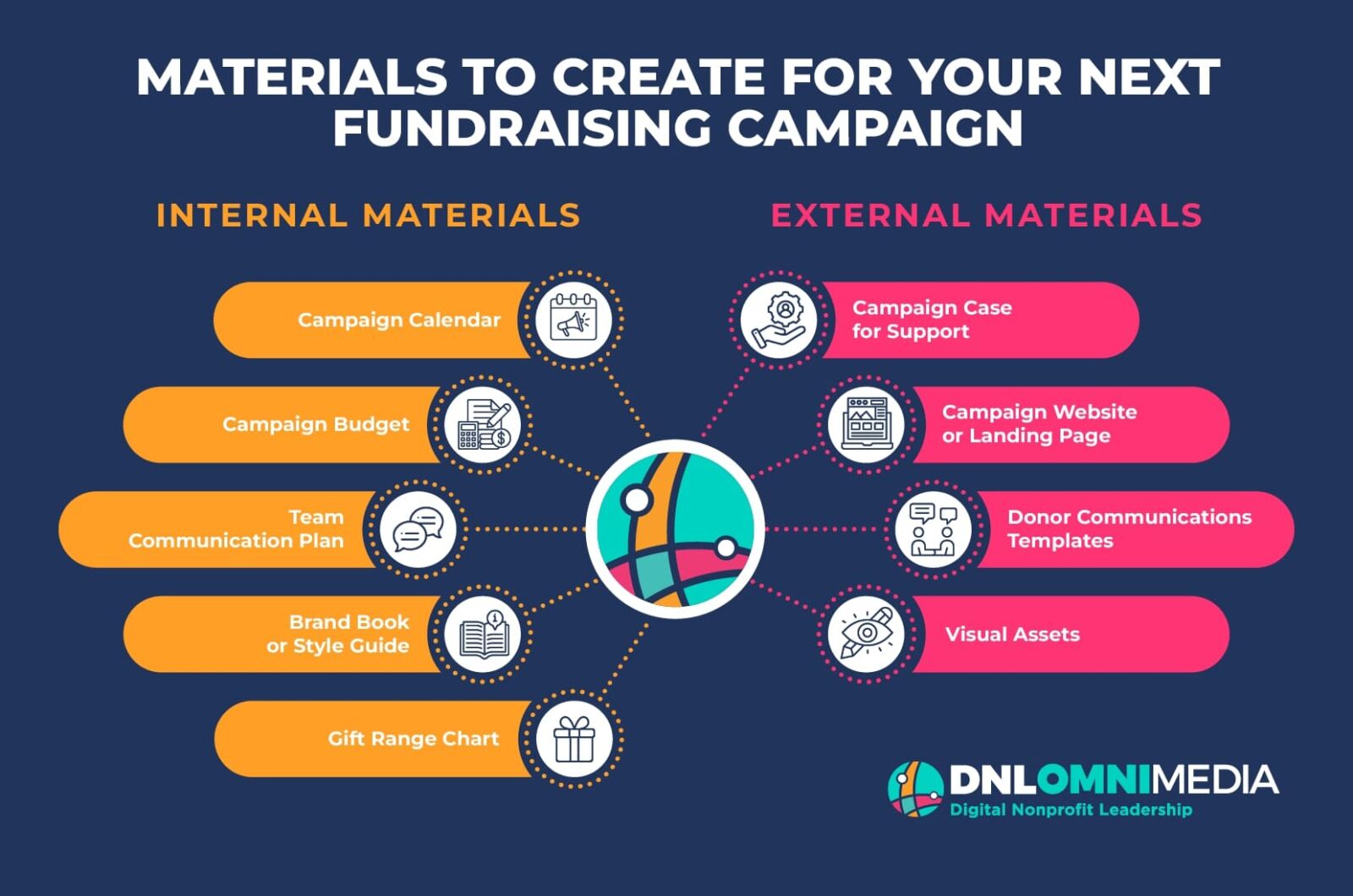
Internal campaign materials
These materials will be used solely by your nonprofit’s team to dole out different responsibilities, keep everyone aligned on the core messages of your campaign, and help everyone stay on track to reach your campaign goal:
- Campaign calendar: Your calendar will lay out the campaign’s timeline, highlighting key milestones like the campaign launch date and end date. It will also help you schedule team meetings, donor stewardship activities, and promotions.
- Campaign budget: The campaign budget should break down the expenses and labor your organization will need to get the campaign off the ground. Though the budget will look different for every campaign, always structure your campaign goal around your intended expenses to ensure you raise more than you spend.
- Team communication plan: This document should outline how your entire team will stay on the same page for the duration of the campaign. List team meeting schedules, communication protocols, and reporting responsibilities.
- Brand book or style guide: A brand book or style guide lays out all of the information about how to present your brand and mission to the world. It should include information about logos, color schemes, organizational values, and messaging that everyone can rely on for external communications. Your organization may already have this asset, but now is a great time to revisit it and ensure everything is up to date. Doing so will allow you to create more consistent marketing materials and help supporters to recognize your brand when they receive messages from you.
- Gift range chart: Especially important for large-scale campaigns like capital campaigns, gift range charts help your team visualize the number of donations you need and at what levels to reach your fundraising goal. A thorough gift range chart can help to guide your fundraising efforts as your team prioritizes outreach to major donors and prospects and then works its way down to soliciting gifts from its broader donor base.
external campaign materials
External campaign materials are those that your donors and other members of your audience will see when you promote the campaign and celebrate your achievements. Focus on creating:
- Campaign case for support: Your campaign case for support, also referred to as a case statement, is a document that lays out why your campaign is important and why your donors should support it. This will start out as an internal document as you design your campaign and get your team on board, but it will eventually become the guiding light for all of your marketing and communication efforts during the campaign.
- Campaign website or landing page: This is a dedicated site or landing page where donors can learn about your campaign, donate online, and track your organization’s progress toward its goals. Share impact statements, testimonials from past campaigns, and campaign updates, and make it easy to take action.
- Donor communication templates: To ensure that your team presents a unified campaign message and consistent communication experience for each donor, create templates everyone can use when interacting with donors. These could be templates for emails, fundraising letters, social media comments, text messages, and whatever other channels you plan to use the most throughout the campaign. Remind your team to personalize messages as much as possible, as this makes donors feel seen and valued as individuals during a campaign.
- Visual assets: Whether you’re posting on social media, writing a blog post, or creating an email newsletter, visuals are an essential part of promoting your campaign. Gather or create images like photos of your beneficiaries and team, infographics and graphic illustrations, and other branded visuals to help break up text and add visual flair to your communications.
6. Focus on building relationships.
Often, fundraisers get caught up in the short-term goals of their fundraising campaigns, like securing a certain dollar amount in donations. However, your fundraising strategy will be far more sustainable and scalable if you think about the big picture and work to build lasting relationships with your donors as you reach your funding goals. This will help you retain your donors from campaign to campaign, securing their support for years to come.
To do this, strive to make every touchpoint with donors a meaningful one. In one-on-one meetings with major donors, ask about their families and careers to get to know them as individuals. Plan your discussions and fundraising asks around their philanthropic interests and priorities. For your broader donor base, do everything you can to personalize your experience with your campaign, whether that means answering a direct message sent to your nonprofit’s Instagram account or ensuring campaign update emails are personalized with donors’ preferred names.
As your organization demonstrates that it values its donors as individuals rather than blank checks, you’ll strengthen your supporter community and build donor loyalty.
7. Provide a smooth and simple online giving process.
Did you know that online giving is the most popular form of donating, with 63% of donors preferring to give online using their debit or credit card? While this is exciting information for fundraisers planning to tap into online giving methods, research shows that 60% of potential donors who land on your organization’s online donation page will leave before completing your donation form.
To ensure your nonprofit doesn’t miss out on gifts to its campaign, revisit your online donation process and apply these best practices:
- Ensure your donation button or links to your donation page are placed prominently in your marketing materials and across your campaign website or landing page.
- Brand the donation form to your organization to assure donors the form is legitimate and secure.
- Remove any questions or fields that aren’t necessary to ensure the donation form is short and easy to fill out.
- Make the form accessible by ensuring it is navigable by keyboard, providing clear instructions for filling it out, and providing clear error messages when a field isn’t filled out properly so that donors can correct mistakes.
- Sync your donation forms with your other technology solutions to allow for automatic thank-you messages and invitations to contribute in additional ways besides donating.
To take your donation process to the next level, consider providing suggested donation amounts to encourage gifts of certain sizes and including options to join your recurring giving program or request an employer matching gift.
8. Make a plan for thanking your donors.
When you eventually reach your campaign goal, avoid the temptation to think of your campaign as complete and turn your focus to other aspects of your work. Instead, make donor appreciation a priority.
Thanking your donors goes hand-in-hand with your other efforts to build relationships with them and can set the tone for your continued stewardship and retention efforts.
There are several ways to thank your donors, from sending an eCard to creating a personalized thank-you video or mailing out a piece of branded merchandise as a token of appreciation. Whatever method you choose should align with your donors’ preferences.
For major donors, it’s likely appropriate to thank them publicly by including them on a donor recognition wall or giving them a shout-out in your nonprofit’s next annual report. Ask your donor for permission before sharing your appreciation with the world—some will still prefer quieter forms of thanks.
Fresh Fundraising Ideas to Engage Donors & Raise More
One common challenge nonprofits face is keeping their donors excited about their fundraising campaigns. This is why it’s so important for your organization to stay open to trying new types of fundraisers. Here are a few of our favorite ideas:
- Start a recurring giving program. Also known as a sustainer giving program, a recurring giving program allows donors to give regular contributions to your nonprofit. Typically, individual donations through these programs will be smaller, but as they add up over time, they’re a reliable and lucrative option for your organization. Consider centralizing this program in a member or supporter center where your donors can manage their contributions and payment information. You can also host sustainer upgrade campaigns to encourage donors to increase the amount they’re giving regularly.
- Pursue different forms of corporate giving. Matching gifts and volunteer grants (where an employer gives a monetary donation to a nonprofit their employees regularly volunteer for) are popular forms of corporate giving. Encourage your donors to take advantage of their employers’ programs by educating them about their options.
- Encourage supporters to participate in peer-to-peer (P2P) fundraising campaigns. P2P campaigns turn your donors into volunteer fundraisers. During these types of campaigns, donors create individual fundraising pages to share with their personal networks and raise money for your cause. Up the ante of this campaign by creating fundraiser leaderboards and giving out prizes to those who raise the most. Use thermometers or progress bars on your website so that fundraisers and donors can easily see progress toward their goals and the impact of each contribution.
- Create a planned giving society. Planned giving is an excellent way for donors to leave a legacy. Educate your donors about their planned giving options and encourage them to seek financial advice from a lawyer or financial advisor. Invite those who commit to giving legacy gifts to join your planned giving society, where you create a community of planned giving donors and cultivate strong relationships with them over time.
- Host an annual gala. A gala is a formal fundraising event that typically features a catered meal, live entertainment, speeches, and fundraising activities like silent or live auctions. Your supporters will enjoy dressing up and attending an elegant event on behalf of a good cause, and your team can take advantage of the opportunity to get facetime with donors and work toward an ambitious fundraising goal.
- Educate donors about non-cash giving. Donors may be interested in giving through DAFs or providing gifts of stock or cryptocurrency, but they may not know where to begin. Provide educational materials about these various giving options to ensure donors can give in a way that works for them.
Choose your fundraising ideas based on your organization’s tone and fundraising approach. For example, if your organization usually holds formal events throughout the year and already has sophisticated major giving and planned giving programs, you probably won’t host something like a charity car wash or virtual talent show. On the other hand, if your organization is one that likes to engage entire families in its work, something like a pet fashion show or trivia night may be great for engaging your donors and securing support.
How DNL OmniMedia Can Help
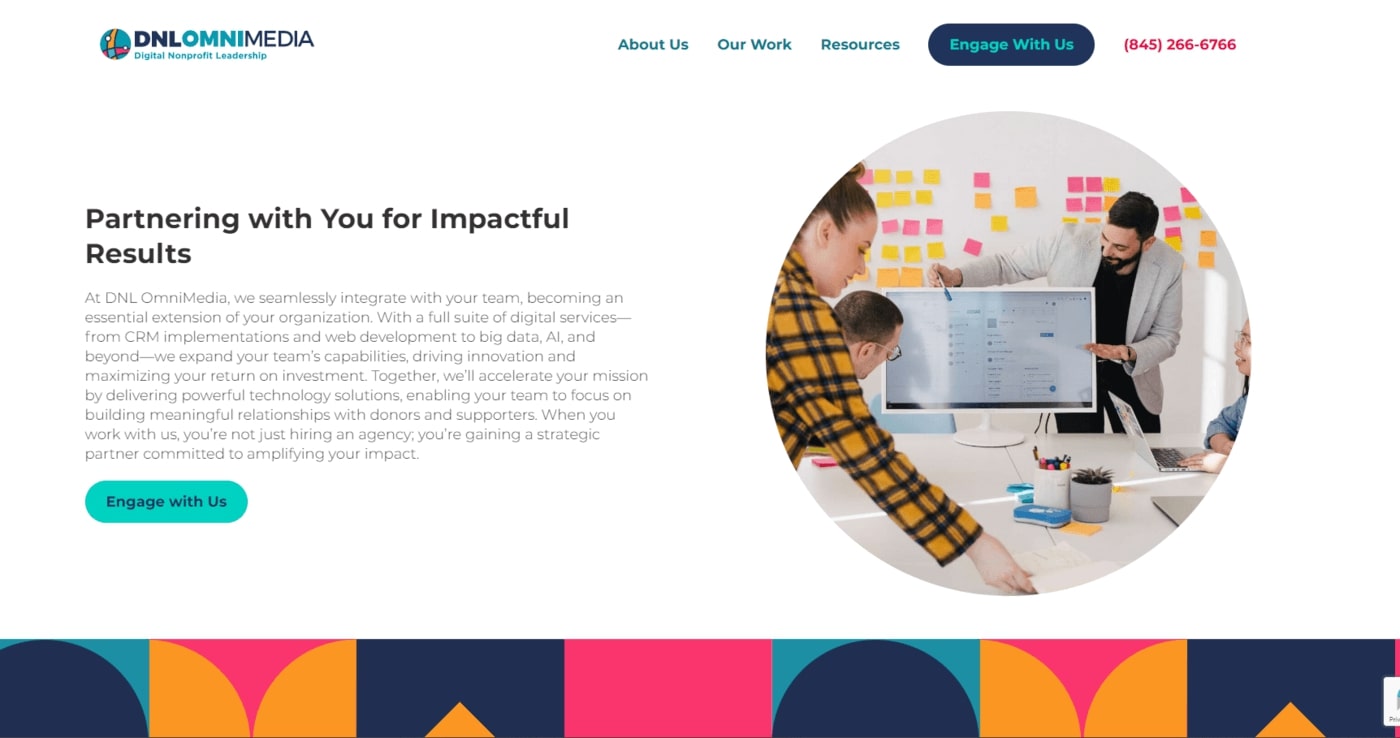
Team DNL can help you acquire, steward, and grow your community of supporters and donors. Our experienced nonprofit fundraisers can support your organization in raising more through the following services:
- DIY/third-party fundraising strategy design
- Peer-to-peer communications creation
- Calendar design
- Sustainer program development and enhancement
- Omnichannel fundraising campaign development and execution
- Automation of donor touchpoints and stewardship tasks
- Donor acquisition campaigns
Our team’s expertise doesn’t end there. We’re also leaders in nonprofit technology consulting, so we can help your organization make the most of its technology solutions to maximize fundraising potential.
Here’s just one example: We’ve worked with the largest no-kill animal shelter in the U.S., the North Shore Animal League America (NSALA), to help them more fully leverage Blackbaud TeamRaiser and new-and-improved donation forms to boost their fundraising outcomes.
Fundraising is an essential part of running your nonprofit, and it comes with a variety of challenges that require you to improve your approach over time. Use this guide to take your nonprofit fundraising strategy to the next level and not only raise the money you need to serve your beneficiaries but also connect with those who support your cause.
Want to keep learning about the world of nonprofit technology and strategy? Check out these recommended resources from Team DNL:
- Nonprofit Marketing: The Savvy Nonprofit’s Ultimate Guide
- Blackbaud vs. Salesforce: A Full Comparison for Nonprofits
- Find the Right Salesforce Nonprofit Consulting Firm: 7 Steps
- Building Your Nonprofit’s Digital Strategy: A Full Guide
- Nonprofit Advocacy: How Your Org Can Drive Positive Change
- Salesforce Nonprofit Success Pack (NPSP): The Ultimate Guide
